Please see our link to Shipping and Return Policies

Please see our link to Shipping and Return Policies
If you are not completely satisfied with your comforter during the first 30 days, return it to us for exchange or a complete refund less the original shipping charge. Also remember if your comforter is not warm enough that we can add down for you if returned within 6 months of the date of purchase. We charge for the additional down added and the return shipping charge. However, due to the internal construction of the comforter, we are unable to lighten it. See our Shipping and Returns page for more information.
All of our comforters are guaranteed to be free from defects in workmanship and materials for a period of 10 years from the date of purchase.
The use of a duvet cover at all times is required to maintain your comforter warranty. A duvet cover is necessary to protect both the fabric and down fill from perspiration stains and oils and the duvet cover should be washed frequently with your bed linens. We are not responsible for damage, abuse, or improper care or for fabric worn or stained by perspiration or oils. Perspiration and body oils not only stain the outer fabric but can be absorbed into the down fill causing it to mat, to lose its loft, and will significantly reduce the life of your comforter. This warranty is given in lieu of all other warranties expressed or implied, including the implied warranties of merchantability and of fitness for a particular purpose.
We are not responsible for damage, abuse, or improper care or for fabric worn or stained by perspiration or oils.
Sateen refers to the weave of the fabric, not the fiber content. Cotton sateen weaves are produced by interlacing long floats of cotton yarn over the face of the fabric. It results in a soft, supple fabric with a subtle gloss. It is a version of the satin weave.
Yes. New sateen sheets do have a gentle shine but that will disappear after washing. However, the fabric will actually become softer and more supple with use. To return some of the luster, remove from dryer while still slightly damp and iron on cotton setting.
With proper care, your investment in fine linens will last many years. All linens that we sell are packaged with care instructions and many have sewn-in labels with laundering instructions/symbols. Please follow your manufacturer's recommendations. Although historically matelasse fabrics are dry clean only, many today are machine washable.
While you should always follow your manufacturer's recommendations, we do not recommend bleach in any form, even for whites. We find that bleach can eventually yellow even white linens, cause damage to the yarns and decrease the life of your fine linens. Use cautions: we recommend that you not use any laundry detergent that contains bleach for any fine linens.
In order to assure uniformity of all linens of the same color and collection, be sure to order all items at the same time. For example, if you need two shams and a coverlet from the same collection and color, try to order all items at the same time. If you order the shams at a later date, there is no guarantee that the colors will be an exact match.
LAUNDERING INSTRUCTIONS
With proper care, your investment in fine linens will last many years. All linens that we sell are packaged with care instructions and many have sewn-in labels with laundering instructions/symbols. Please follow these guidelines. We recommend laundering unless dry cleaning is specifically recommended on the product. Unless otherwise specified, all fine linens should be laundered separately on a gentle cycle in warm water.
DO NOT BLEACH OR USE DETERGENTS THAT CONTAIN BLEACH OR WHITENERS.
WARNING: The use of face creams containing benzoyl peroxide, alpha hydroxy or other similar ingredients will cause white and/or yellow staining of all fine bed and bath linens.
Dry on low heat and remove promptly. Smooth out wrinkles, fold and enjoy. Almost all better quality linens are made of 100% cotton. Cotton is the most comfortable of all fibers. Most of our customers simply enjoy their linens and do not worry about ironing. The "rumpled" look is expected.
SHRINKAGE
Shrinkage can range from as little as 2% to 4% or as high as 10%, depending on the fibers used. Hot water and excessive heat will greatly increase shrinkage.
These rugs may be machine washed on low temperatures and gentle cycle. Please use gentle detergents. Do not use bleach, detergents containing bleach, or liquid fabric softeners. Tumble dry on low temperatures; shake rug after drying to the re-fluff pile. Do not vacuum.
The use of face creams containing benzoyl peroxide, alpha hydroxy or other similar ingredients, as well as teeth whiteners, will cause white and/or yellow staining of all fine bed and bath linens, including white and colors.
First, if properly covered with a protective duvet cover, down comforters need very infrequent cleaning. When you must clean it, we suggest that you have your comforter PROFESSIONALLY LAUNDERED IN WATER. We do not recommend dry cleaning fluid. Spot clean the outer fabric as needed.
Please contact our down specialists if you have questions about cleaning. Comforters should not be washed at home. Down comforters are too large for home washers, and if the fabric is torn by the agitator the down can escape, damaging your washer and possibly causing the water to back up into the laundry room. Down comforters must be dried thoroughly, often requiring several hours in a large format or commercial dryer set on low heat. We do not recommend the use of fabric softeners or dryer sheets. These products leave a residue and destroy the natural abilities of down to insulate and loft. Drying time will depend upon size & weight/warmth level. It should be removed frequently throughout the drying process to fluff. As it dries, the comforter may expand so much that it will block the escape of hot air from the dryer, resulting in a scorched comforter and a risk of fire. A down product should not be left in a dryer unattended. Professional laundries should be fully capable of managing their cleaning process. After washing, do not store in plastic, but allow to air for several days. Your DEWOOLFSON Down product came with a breathable bag.
If you need assistance in cleaning your comforter, please call us at 1.800.833.3696
If you are not completely satisfied with your comforter during the first 30 days, return it to us for your choice of a complete refund of your money or exchange.
All of our comforters are guaranteed to be free from defects in workmanship and materials for a period of 10 years from the date of purchase. Our featherbeds are guaranteed according to the same terms and conditions for a period of 5 years from the date of purchase.
Remember the use of a duvet cover at all times is required to maintain your comforter warranty and the use of a featherbed protector at all times is required to maintain your featherbed warranty. A duvet cover is necessary to protect both the fabric and down fill from perspiration stains and oils and they should be washed frequently with your bed linens.
We are not responsible for damage, abuse, or improper care or for fabric worn or stained by perspiration or oils.
Probably not. The warmth of a comforter is determined by its volume or its thickness, in other words, by its loft. The loft is determined by both the amount of down inside (in ounces) and by the quality of the down itself (its fill power). So, we can make your comforter as full and lofty as you like, but that will certainly cause it to trap more body heat and be warmer. And remember our usual advice. If you are uncertain or if this is your first down comforter, always select one weight lighter than what you think you will need because we can always add down to your comforter, we cannot remove down. Due to current health concerns, we must temporarily suspend our comforter and pillow adjustment service. We hope to offer this service again in the future. If you are considering a Canadian Winter weight, we are available to help with your decision at 1-800-833-3696.
.The biggest difference between our different downproof fabrics is in their weight (exclusive of fill). A batiste weave, for example, creates a finer and lighter fabric than a cambric weave. So if you want a comforter that has "warmth without weight" then consider a batiste fabric. In making your selection you might find that not all fabrics are available in all weight comforters. Batiste fabrics, for instance, are generally best used with the lighter weight comforters.
Our Downproof Fabrics
|
Our Original Cambric |
Austrian Cambric |
Batiste |
Our Newest Nano Batiste |
Austrian Lyocell Batiste |
| Fiber Content |
Cotton | Cotton | Cotton | Cotton | 55% Cotton | 45% Natural Lyocell |
| Fabric Weight Comparison |
140 gm./M2 | 25% lighter than Cambric | 36% lighter than Cambric | 50% lighter than Cambric | 48% lighter than Cambric |
| Recommended for these warmth levels |
Florida Light Southern Light Carolina Piedmont Mountain Air Canadian Winter |
Florida Light Southern Light Carolina Piedmont Mountain Air |
Florida Light Southern Light Carolina Piedmont |
Florida Light Southern Light |
Florida Light Southern Light Carolina Piedmont |
| Down fills offered in each fabric |
650 and 750 fill | 650 and 750 fill | 650 and 750 fill | 750 and 850 fill | 900 fill |
The most important factor in determining the warmth of your comforter is the number of ounces of down fill inside. We offer five warmth levels that vary according to the weight of the fill in each. We suggest you choose a comforter that seems like the best fit for your climate or region. Of course, you should also consider the time of year that you'll use it, your bedroom temperature, and whether you are a cold or warm sleeper.
Our Mountain Air and Canadian Winter down comforters have a beautiful loft similar to the warmest comforters of northern Europe, especially when filled with the better quality down fills (see below). However, they are extremely warm and best suited for bedrooms in the coldest climates or during winter with the thermostat turned way down!
FLORIDA LIGHT |
SOUTHERN LIGHT |
CAROLINA PIEDMONT |
MOUNTAIN AIR |
CANADIAN WINTER |

|
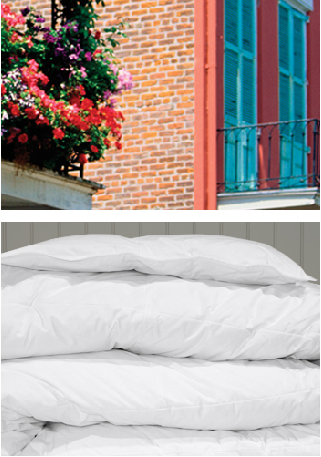 |
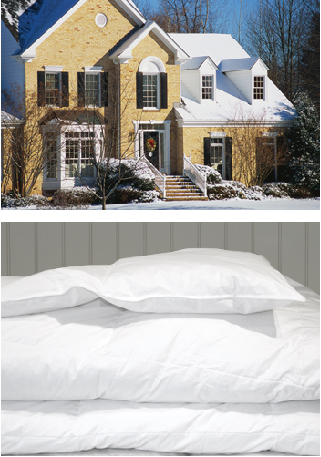 |
 |
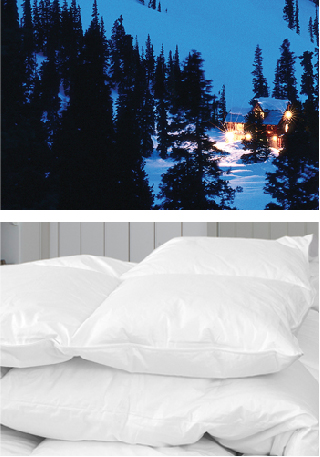 |
|
|
|
|
|
|
lightest weight |
light weight |
medium weight |
warm weight |
warmest weight |
Choose this for a delicate warmth |
Choose this if you sleep warm |
Choose this if you often sleep cold |
Choose this if you are always cold |
Like the comforters of Northern Europe |
Available in fabrics:Our Original CambricAustrian CambricBatisteNano BatisteAustrian Lyocell Batiste |
Available in fabrics:Our Original CambricAustrian CambricBatisteNano BatisteAustrian Lyocell Batiste |
Available in fabrics:Our Original CambricAustrian CambricBatisteAustrian Lyocell Batiste |
Available in fabrics:Our Original CambricAustrian Cambric |
Available in fabrics:Our Original Cambric |
A down comforter can be made warmer in two ways, either by adding additional ounces of fill or by increasing the quality of the fill. One estimate of the quality of down fill is a measurement called "fill-power." Fill-power is a commonly used term to describe the down's ability to loft and trap air, expressed in cubic inches per ounce of fill. For example, a 650 fill-power down means that one (1) ounce of down will expand to reach a volume of 650 cubic inches. This means that comforters with a higher fill-power down will have somewhat greater loft and warmth. But fill-power is also generally reflective of the overall quality of the down. A higher fill-power results from having larger down clusters and fewer fine feathers. And this comes from healthy flocks in cooler climates, good farming practices, better techniques in down washing and sorting, and careful transport and handling of the fill. Larger cluster down also tends to retain its loft longer over time.
Fill-power is not only a measurement of the overall quality of the down in your comforter, but ounce-for-ounce will also affect its warmth. Each step up in fill quality will increase the loft of your comforter and make it slightly warmer. We estimate, for example, that a 750 fill-power down comforter would be approximately 15% warmer than the same weight comforter filled with 650 fill-power down. This means that you could choose a comforter with fewer ounces of down, but have almost the same warmth level as one made with more ounces. For example, customers have told us that a 750 or 850 fill-power Florida Light weight comforter seemed almost equivalent to our Southern Light weight made with a 650 fill-power down. So if you are looking for "warmth without weight" consider a lighter weight comforter (with fewer ounces) but a higher quality down.
All DEWOOLFSON down fills are responsibly sourced, all-European down that is washed, sorted and tested in the USA. Please allow 1 to 3 business days for your comforter to be filled, finished and shipped from our North Carolina plant.
We make this suggestion because we can add down to your comforter if returned to us within 6 months of purchase, but we cannot remove down. We do charge for the additional down added and for return freight. Some health-related restrictions apply so please contact DeWoolfson customer service for a return authorization.
The warmth of a comforter is determined by the amount of down fill (measured in ounces) and by the quality of the fill (measured by fill power).
• The measurement of the ability of down to loft and trap air.
• 1 ounce of 750 fill down will fill a volume of 750 cubic inches.
• The average fill power for most down products is approximately 550 cubic inches. For comparison, below is a representation of DeWoolfson’s 650 and 750 fill power down.
• 750 fill power down is 15 percent warmer and fluffier.
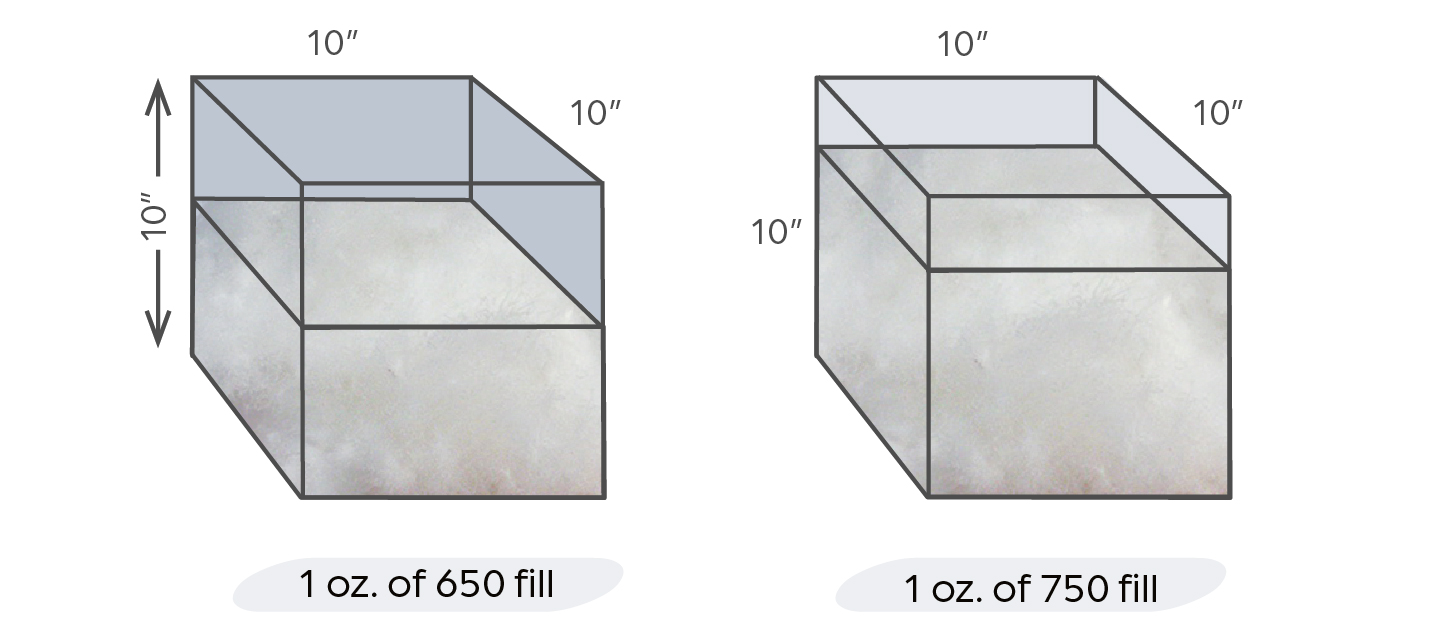
• Internal fabric walls separate the top & bottom layers of fabric.
• Holds the down securely in place to prevent shifting, while allowing the down to reach its maximum loft.
• Adds strength to the comforter - allowing "give", which reduces stress on the stitching when tossing & turning at night.
• We sew our baffles with all internal seams so that no threads are visible on the outside of the comforter.
• Our exacting internal construction and close sewing tolerances minimize the potential for the down to shift.
• Ability to add additional down to your comforter within one year from the date of purchase to increase the warmth level.
• Creates a more supple comforter by allowing the comforter to settle down around you and envelope you in its warmth.
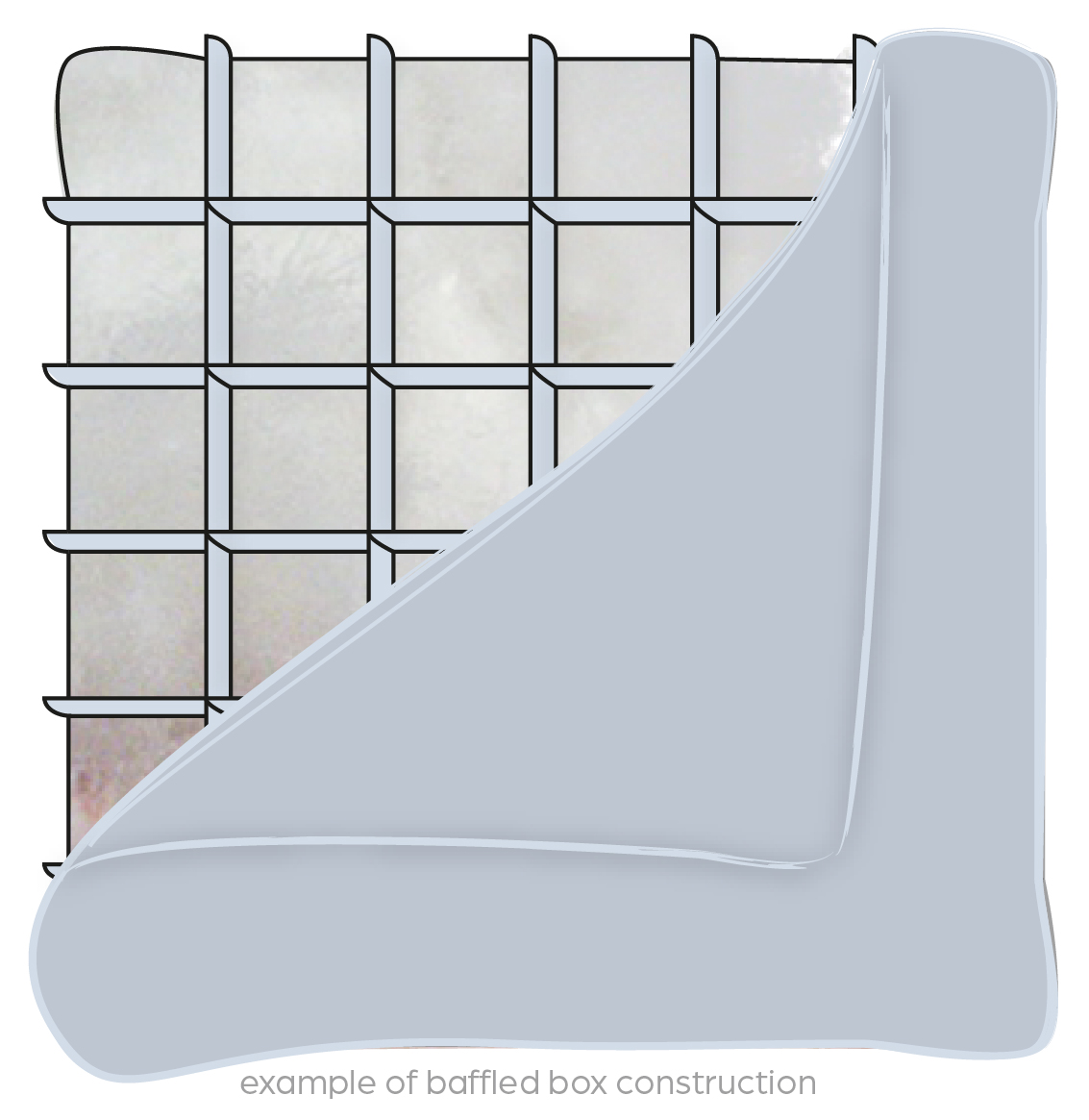
Duvet is simply the French word for down, but it is commonly used to refer to a comforter. A duvet cover is a comforter cover that protects your comforter and can be removed for regular washing. And it can be color coordinated to your bedroom. A down comforter with a duvet cover can become your bedspread, blanket, and top sheet - all rolled into one. It's a fun, cozy way to sleep.
We recommend that your duvet cover is made from lightweight, sheet-type fabrics, preferably from cotton or even silk. The lighter the better. While tapestries and matelasse are fine for coverlets or bedspreads, they are too heavy to sleep under comfortably. We also caution against using heavier weight chintz fabric, such as that used for upholstery or draperies. It also is too heavy for good sleeping. Most Americans prefer to sleep with an additional top sheet, so they will have to launder their duvet cover less frequently. But for a really cozy sleep, we highly recommend that you be daring - sleep under the duvet cover without a top sheet. It's lighter, less restricting, the traditional European way, and our favorite.
Yes, we do. You are probably referring to the comforter widely used in Germany that is 135 x 200 centimeters, or 54 x 78 inches. We also refer to this as our Euro-size or our individual-size comforter. This Daunendecke is just large enough for one person to wrap up into sleep, and is often preferred over those in the U.S. that cover the entire bed. With a duvet cover, it is like wrapping up in a big jelly roll! We do these in several downproof fabric choices, and they can be filled to any weight, although the ones used in Germany are quite full. Prices are comparable to those comforters shown in our regular line. We also stock duvet covers in this size in solid colors and prints.
| German | 54” x 78” |
| Twin | 68” x 92” |
| Queen | 92” x 92” |
| King | 110” x 92” |
| Cal. King | 107” x 96” |
| Des. King | 115” x 96” |
All DeWoolfson down and feather fills originate from Europe, with washing, rinsing and sorting in the U.S.A.
The fill is washed in state-of-the-art equipment, using quality soaps, emulsifiers, and solutions designed for cleaning down fill. All fill is subjected to continued cleaning and rinsing cycles to assure cleanliness and purity. The fill is then temperature dried and air sorted to assure compliance with our quality standards for down and feather content and fill power. The fill is then carefully sorted to separate down from feathers, according to DeWoolfson’s quality standards.

• The measurement of the ability of down to loft and trap air.
• 1 ounce of 750 fill down will fill a volume of 750 cubic inches.
• The average fill power for most down products is approximately 550 cubic inches. For comparison, below is a representation of DeWoolfson’s 650 and 750 fill power down.
• 750 fill power down is 15 percent warmer and fluffier.

We urge customers to beware of fake coupons or coupon codes, whether online or in print, and to know how to recognize coupon fraud. DEWOOLFSON cannot recognize or honor any purported coupon or coupon code other than those that it officially issues. Official DEWOOLFSON coupons and coupon codes are an invitation and not to be construed as an offer, and may be terminated by the company at any time. DEWOOLFSON does not issue coupons through third-party sites. Coupon fraud is a serious offense as well as copyright and trademark infringement.
We cannot accept orders for international shipment at this time.
DEWOOLFSON is the name of the company founder's family. The family lived in London during most of the 19th Century. One of the sons of Theodore DeWoolfson and Maria Estevan arrived in the United States around 1910 on the Cunard Line's Lusitania.
• Do not place any down or feather products in a crib.
• Do not allow infants or small children to sleep or nap, or otherwise be left unattended, on a down comforter or featherbed.
1. There is the chance that if the fine fabric shell tears or opens that the infant can inhale the fine down clusters or feathers and choke.
2. A down comforter is capable of covering an infant's mouth and blocking airways, whether it is on top of the infant or under them.
3. There is considerable scientific evidence that infants who become over heated have a greater incidence of Sudden Infant Death Syndrome (SIDS). Down comforters and featherbeds are extremely heat-trapping and may add to this risk.
For more information, please read our Infant and Child Warning Label attached to every DeWoolfson Down comforter and featherbed.
Only coupons issued directly from DEWOOLFSON can be honored. We issue coupons only through our newsletters, direct mail and on DEWOOLFSON websites. DEWOOLFSON does not issue coupons through third-party sites. Coupon fraud is a serious offense as well as copyright and trademark infringement. We urge customers to beware of fake coupons or coupon codes, whether online or in print, and to know how to recognize coupon fraud. DEWOOLFSON cannot recognize or honor any purported coupon or coupon code other than those that it officially issues. Offical DEWOOLFSON coupons and coupon codes are an invitation and not to be construed as an offer, and may be terminated by the company at any time.
All pillows eventually get softer and "break-in" with use as a result of absorbing body oils and moisture. This is a natural and unavoidable process. Yellowing and staining on the outer fabric is a good indication that body oils and perspiration have been absorbed into the down itself, most likely causing the down to mat, clump, and deteriorate. This is a gradual process and happens to both natural and synthetic-filled pillows. A pillow protector is the best way to protect your down pillow, provided you remove it and wash it often. We'll add that we've noticed that down pillows last far longer in dry climates and in air-conditioned bedrooms. Consider the relative cost of your pillow to the years of comfort and use you will receive. It seems reasonable that a pillow, like everything else, should be replaced after its usable life. We can adjust the firmness of your new DEWOOLFSON pillow any time within 6 months of the date of purchase. We do charge for additional fill and return shipping. Due to current health concerns, please contact customer service for guidelines and return authorization before returning any pillow for adjustment.
Please store all down products in a dry place and in a breathable bag or pillowcase. Humidity destroys down causing it to lose its loft and its ability to insulate. Your pillows will go 'flat' more quickly - lose their loft - and be less supportive impacting their usefulness if not kept in a dry environment.
We recommend stomach sleepers choose a soft pillow, a firm pillow for side sleepers (to keep your head level) and a medium firmness pillow for back sleepers. We often hear from customers who suffer from headaches and discomfort from sleeping on the wrong pillow. Of course, we make no claims about curing headaches. Although, the right pillow can make a difference in a comfortable night’s sleep. We even hear from customers who complain of “neck aches” from sleeping on a too-firm pillow. For these people, we recommend a softer pillow that fits into the curve of their neck, permitting the head to slightly tilt backward, relieving stresses on the neck area. If you sleep on your stomach, choose a soft or extra soft pillow so that the pillow doesn’t push your head up too high. And if you sleep on your side, choose a pillow that is firm enough to fill the breadth of your shoulders and to allow your head to remain at a comfortable level. We can adjust the firmness of DEWOOLFSON pillows only if returned to us within 6 months of purchase. We do charge for additional down and return shipping. Any down removed will be returned to you. Due to current health concerns, please contact customer service for guidelines and return authorization before returning any pillow for adjustment.
Down is the soft, fluffy undercoating of geese and ducks. When used in a pillow or comforter, down easily traps air and lofts or "balloons." The higher the "fill power" of down, the greater the loft (diagram below). Feathers are the outer layer of plumage that covers and protects the down, do contain a quill, and because feathers are flatter than down they do not loft as well. Those DeWoolfson products that do contain feathers are made only with very small, delicate feathers and are always combined with a certain percentage of down. Although both down and feather pillows are available in soft, medium, or firm, their "feel" is different.
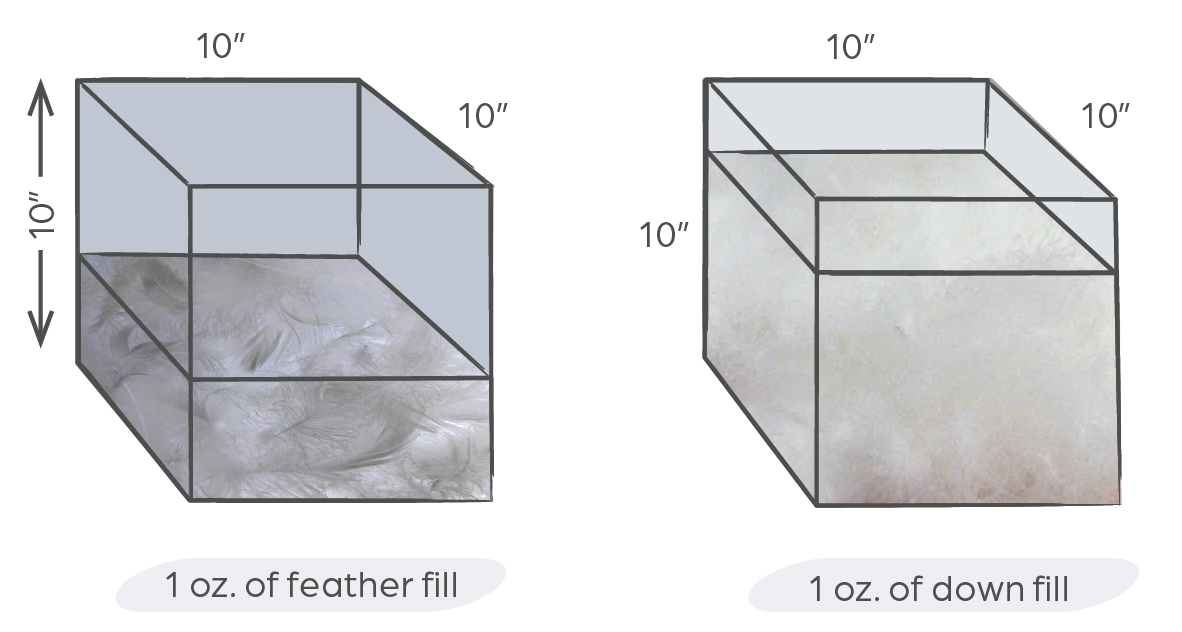
We’d be glad to make any size or shape pillow and fill your pillow with your choice of white goose down, feathers or a down/feather blend.
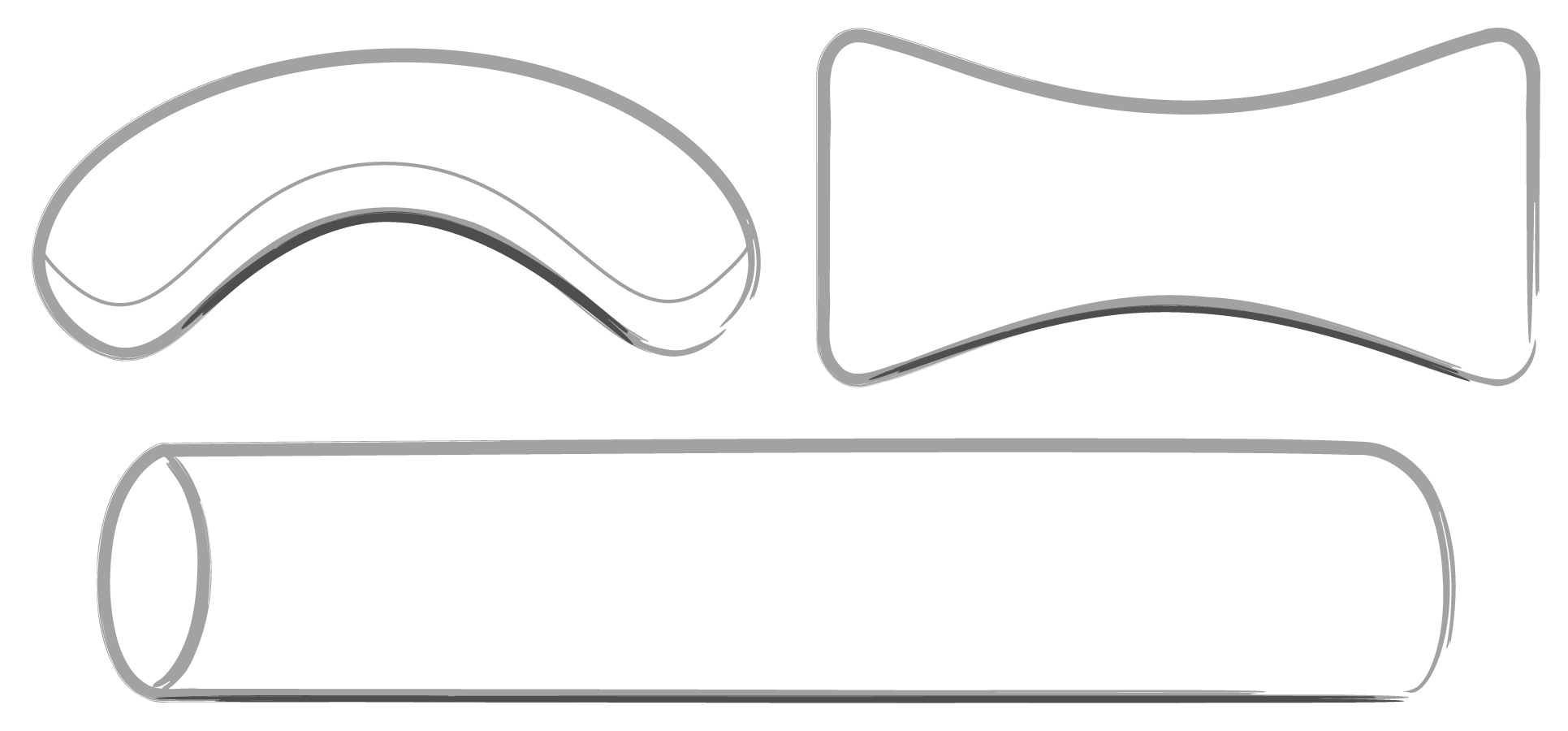
While we hear of customers who have had success in washing pillows, we have many who tell us that it is extremely difficult. We do NOT recommend washing in your home washer, especially in a top-loading washer with a rotating agitator. If the agitator tears the fabric and the down escapes, it can block the water exhaust and overflow onto the floor. This is possible with older pillows whose fabric is weakened from oils, perspiration, and age. Next, pillows tend to trap air and "balloon," causing them to pop out of the top of the washer (and you may have to work the water into the pillow). So, we recommend washing only in a front-loading commercial washer, using regular laundry detergent. You may have to help work the water into the pillow. But even here, be sure that the fabric is not too old or deteriorated from body oils or weakened from age. When the pillows are wet you may smell a pungent odor. This odor is natural with all down products and will disappear when the pillows are completely dry. Be certain to dry the pillows very thoroughly so that they don't mildew inside. This will take three or four hours in a large commercial dryer on medium heat. Pillows in a hot commercial dryer can easily burn so be careful and don't leave them unattended in the dryer. Take them out and fluff occasionally when drying. The use of tennis or dryer balls can help fluff and redistribute the down. We do not recommend the use of fabric softeners or dryer sheets. These products leave a residue and destroy the natural abilities of down to insulate and loft. Our best recommendation is to use a good quality pillow protector, wash and change it weekly with your laundry, and discard the pillow when its life expectancy is over.
We can adjust the firmness of your new DEWOOLFSON pillow only if returned to us within 6 months of purchase. We do charge for additional down or feather fill and for return shipping. Any down removed will be returned to you or discarded. It takes approximately 4 ounces in a standard size bed pillow to adjust it one step in firmness and approximately 6 ounces in a king pillow. Of course, you can request as little or as much fill as you would like. Each quality and type of down is priced accordingly. Please contact customer service for advice and pricing.
Please understand that we cannot accept a pillow for adjustment that has blood stains or signs of bodily fluids. Also, certain COVID-related guidelines for safe handling of pillows and comforters are in effect, so there might be a short delay in adjusting your pillow or comforter.
Our goal is to ensure that your new purchase is exactly the way you want it. Whether you like it extra soft or prefer a more supportive pillow, we will be glad to customize any pillow for you.
All DeWoolfson down and feather fills originate from Europe, with washing, rinsing and sorting in the U.S.A.
The fill is washed in state-of-the-art equipment, using quality soaps, emulsifiers, and solutions designed for cleaning down fill. All fill is subjected to continued cleaning and rinsing cycles to assure cleanliness and purity. The fill is then temperature dried and air sorted to assure compliance with our quality standards for down and feather content and fill power. The fill is then carefully sorted to separate down from feathers, according to DeWoolfson’s quality standards.

• The measurement of the ability of down to loft and trap air.
• 1 ounce of 750 fill down will fill a volume of 750 cubic inches.
• The average fill power for most down products is approximately 550 cubic inches. For comparison, below is a representation of DeWoolfson’s 650 and 750 fill power down.
• 750 fill power down is 15 percent warmer and fluffier.

The life of your pillow depends on a number of factors. The absorption of body oils, perspiration, and humidity through the cotton shell and into the down cause a pillow to lose its loft and become softer. If you see yellowing of the outer pillow fabric or staining then you know that the natural process is taking place. A pillow protector will help protect your down pillow, provided you remove it and wash it often. We've noticed that down pillows last far longer in dry climates and in air-conditioned bedrooms. But remember, this happens to synthetic pillows as well. Consider the relative cost of your pillow to the years of comfort and use you will receive. It seems reasonable that a pillow, like everything else, should be replaced after its usable life. We can adjust the firmness of new DEWOOLFSON pillows only if returned to us within 6 months of purchase. We do charge for additional down and return shipping. Any down removed will be returned to you. Due to current health concerns, please contact customer service for guidelines and return authorization before returning any pillow for adjustment.
Those occasional dark spots that you see through the fabric are dark clusters of down, usually gray or light brown. They are found in all white goose down fill, regardless of quality, and the more you press on the fabric the more you'll see them. Even white geese have a few gray clusters, and there's no way around that. DeWoolfson uses "white goose down" because a pillow or comforter made from "gray goose down" gives the final product a discolored or dingy appearance.
Placing reliance on thread count as an indicator of the downproof quality of fabric is a mistake. What is important is the type and size of yarn, the density with which it is woven (which is a different issue than thread count), and the specialized finishing techniques needed to insure the fabric's downproof qualities.
We use several different types of fabrics on our comforters and pillows. Most are made from fabric woven by specialized textile mills that have been weaving downproof fabrics for over a century. These fabrics offer the ideal combination of downproof qualities, strength and durability, and a fine hand. Their downproof character is derived from the fact that they combine the appropriate size yarn necessary to provide durability over years of use with a dense weave.
While our thread counts range generally from 226 to over 400, we do not think that consumers should focus on this issue. In our nearly 40 years in business, we have seen high thread count fabrics woven by less experienced mills, or with inadequate quality control or finishing processes, that have leaked down excessively. Our experience is that thread counts under 300 actually provide the best combination of durability, absorbency, performance, and feel. Fabric can be woven densely at 226 threads, or at 400 threads. But in order to weave more threads per inch, each yarn has to have a smaller diameter. This results in a cloth that is too fine and delicate for the heavy use that pillows and comforters take at night. The fabric must be durable enough to hold down and feathers, to hold the stitching over many years of "tossing and turning" and to withstand exposure to perspiration. Indeed, the weave in our 226 thread count cambric is actually "tighter" than most fabrics that are advertised at twice the thread count; it's just that the yarns are of the optimum size and density.
Additionally, the fabric is calendered in the finishing process by being put under tremendous pressure and heat to assure complete downproofness and fine touch.
The thread count on the pillows ranges from 226 to a 280 thread count twill, and we do match the weave to the relative percentage of down and feather blend being used. Every blend of fill requires a different fabric.
WHAT IS A LAW LABEL?
A “law label” is a disclosure label required by state law to be sewn into every bedding product made of filling encased in an outer cover. This includes comforters, pillows, featherbeds and mattresses. The label must disclose, in language specified by law, the type of filling, and in the case of down products, the exact percentage of down and feathers. This is the best way to determine the exact contents of the product you intend to buy – because advertising and packaging regulations are vague and rarely enforced.
Law labels may be attached only by bedding manufacturers and others licensed to do so. The agencies which license manufacturers and regulate the content of their law labels are usually a part of a state’s department of public health.
HOW DO I TELL IF MY PRODUCT REALLY CONTAINS DOWN OR FEATHERS?
First, understand three terms: down, feather, and fiber. Down is the soft, fluffy clusters taken from the undercoating of geese or ducks (and it is many times more expensive than feathers). Feathers are the bird's outer covering, and have a hard, spiny quill. Down has little weight, but great insulating abilities. Feathers are relatively inexpensive, but are heavy and do not insulate nearly as well. Fiber refers to pieces of damaged or broken down clusters or feathers. ALL THREE OF THESE ARE PRESENT IN PRODUCTS SOLD AS “DOWN.” This is because the mechanical process used to sort down from feathers is not perfect. Some feathers and fiber, in trace amounts, will always remain in the purest down fill. So, it is inaccurate and contrary to law, to state that a product contains "all down," "pure down," or "100% down." Don't let a salesperson tell you that it does.
Recognizing that all down products contain some trace of feathers and fiber, new regulations require manufacturers to tell you the minimum percentage of down clusters in the product. As long as it contains at least 75% white goose down clusters, the product may be labeled as "white goose down." However, that label must also state, in a slightly smaller typeface, that the product actually contains "minimum 75% down.” (75% down is actually pretty average for most down products offered for sale in the United States today). A better quality down that measures 650 fill power might be labeled as "minimum 85% down" clusters. Thus a typical 650 fill power down pillow might be labeled as follows:
This product contains all new material
consisting of
WHITE GOOSE DOWN
(minimum 85 percent down)
The 85 percent does not mean that the product is inferior. Indeed this item would contain over 13 percent more "down" clusters than the 75% minimum that is required by law. And remember, any product with 85% down clusters would have such a small trace amount of feathers and fiber that it would be virtually undetectable. Moreover, it is practically impossible to mechanically sort the down finer than 90 to 95 percent (about a 750 fill power down rating).
WHAT NEED NOT APPEAR ON A DOWN LAW LABEL?
Although every state has different disclosure requirements, many states do not require that the color or the species of the bird be disclosed. For instance, many states allow the use of the term “white down” without stating if it is made of goose or duck. Similarly, many states allow the term “goose down” without disclosing if it is gray or white. Beware of feather pillows labeled "crushed feathers" as they are made of large feathers in excess of the legal limit to be sold as whole feathers, and had to be crushed in order to be used.
Of course, there are many variables that determine the quality of a down or feather fill . . . .and in the end, the best advice is to purchase only from a manufacturer that you trust.
ARE YOU ALLERGIC TO DOWN . . . OR TO MOLD?
Before we talk about allergies to down, keep in mind that there are probably more people allergic to mold or dust mites than to new down fill. We often hear stories of someone who won't sleep on a new down pillow because they once had an allergic reaction to one while sleeping at "grandma's house." Before you give up the great comfort of a down pillow, consider whether that old pillow was stored in a damp, mildew-prone area of the house. If so, you may not really be allergic to down at all.
USE OF THE TERM HYPOALLERGENIC:
DeWoolfson Down will never use the term "hypoallergenic" with regard to any down or feather product because we do not believe that the use of the term is appropriate. Anyone who is allergic to goose dander is simply going to be allergic to goose down. There is no scientific basis for concluding that washing and rinsing down, no matter how well, or by treating it with any solution, will remove 100% of the dander, or result in hypoallergenic down, and we encourage you to beware of claims otherwise.
To illustrate, if you are allergic to eggs, there is no way to process them, treat them with chemicals, cook them or bake them, that will prevent an allergic reaction. Indeed, science tells us that we would have to alter the DNA molecule in order for someone with true allergies to no longer be affected by that allergen. An impossible task indeed. It is common sense that washing down and feathers will not prevent it from causing an allergic reaction in those who are truly allergic.
WASHING AND RINSING:
DeWoolfson Down's quality fills do go through state-of-the-industry washing and processing in specialty down soaps, containing surfactants and emulsifiers, with German-engineered equipment. Our down undergoes multiple washing and rinsing cycles, to assure cleanliness and sanitation. Air drying includes a specialized de-dusting vacuum system that further removes dander and fine particles. Despite this level of cleaning and processing, we will not label even our finest down fills as "hypoallergenic".
DEWOOLFSON USES NO CHEMICAL FUNGICIDES OR MOLDICIDE IN ITS FILL:
We believe that some companies using the term hypoallergenic are referring not to allergies to down, but to allergies to molds or spores that can form in pillows or comforters that are not properly cared for. We have seen claims that some down is treated with anti-mold and fungicides that will retard the growth of bacteria and spores. In using the term "hypoallergenic" these companies may be referring to allergies caused not by down, but by mold. Our experience has shown, however, that these chemicals are toxic and not something that we, or our customers, would want to sleep under every night. We know of one case where an employee was exposed to these chemicals, causing burn-like blotches that required several weeks of treatment. It's far easier and safer to just store your down products carefully, and like anything else, away from damp areas.
DUST AND DUST MITES:
Keep in mind that many people truly are allergic to dust and dust mites. While mites can attach to the surface of the comforter, scientific studies done in Europe have shown that dust mites cannot penetrate the downproof fabrics used in down comforters, pillows or featherbeds. We recommend a good duvet cover that closes securely and is laundered often. DeWoolfson pillow protectors are made from downproof fabric and are inherently dust mite proof.
In conclusion, if you are truly allergic to down, then we recommend that you select another product.
DeWoolfson purchases its downproof fabrics only from companies that subscribe to or follow practices for the production of ecologically safe textiles. That means DeWoolfson's suppliers are committed to the production of textiles that are safe for the environment and safe for you. These textiles are produced without the use of harmful chemicals such as chlorine, formaldehyde, dyes, other heavy metals such as chromium, or other toxic chemicals. DeWoolfson also offers down comforters, pillows, and featherbeds made from organic cotton and environmentally sustainable Tencel™ (lyocell fiber) made from low impact eucalyptus fibers in a closed-loop process.
DEWOOLFSON uses only down and feather fills that originate from Europe. All fill is sterilized, washed, rinsed and sorted in the U.S.A.
The fill is washed in state-of-the-art equipment, using quality soaps, emulsifiers, and solutions designed for cleaning down fill. All fill is subjected to continued cleaning and rinsing cycles to assure cleanliness and purity, and processing is subject to the supervision of the state's health department. The fill is then carefully sorted to separate down from feathers, according to DEWOOLFSON’s quality standards.
DeWoolfson ® is a registered trademark of DeWoolfson Down International, Inc. Copyright © 2006-2026 All rights reserved. Hosted by OverMountain Studios Inc.